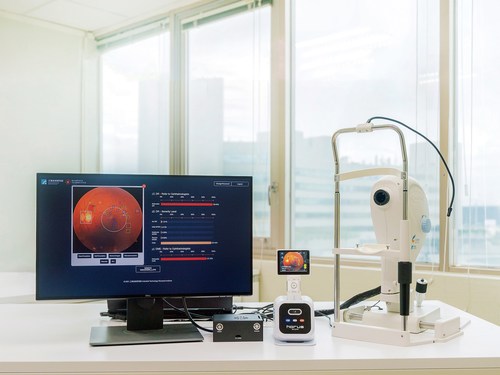ITRI Introduces Point-of-Care AI-DR Software for Rapid Diagnosis of Diabetic Retinopathy and Diabetic Macular Edema
2022-11-10
Point-of-Care AI-DR is the first AI-assisted system which can be integrated into handheld and desktop fundus cameras used to detect diabetic retinopathy and diabetic macular edema
HSINCHU, Nov. 10, 2022 /PRNewswire/ -- The Industrial Technology Research Institute (ITRI), Taiwan's largest and one of the world's leading high-tech applied research institutions, today introduced Point-of-Care AI-DR, the first AI-assisted system which can be integrated into handheld and desktop fundus cameras commonly used in hospitals and clinics to detect diabetic retinopathy (DR) and diabetic macular edema (DME). Point-of-Care AI-DR is a 2022 R&D 100 Awards winner in the software/services award category.
Continue Reading

Preview
来源: PRNewswire
Point-of-Care AI-DR is the first AI-based solution that can locate four main lesions, classify five severity levels of DR, and determine whether a patient should be referred to an ophthalmologist.
Point-of-Care AI-DR diagnoses DR and DME in 5 to 10 seconds and instantly assesses image quality before diagnosis to prevent misinterpretation by the AI. It marks lesions and assesses the corresponding severity levels based on the fundus images. Further, Point-of-Care AI-DR can identify 14 other common ocular fundus abnormalities, including retinal related diseases, changes in blood vessels, and optic nerve related diseases.
Point-of-Care AI-DR is easy to use, so general physicians can perform early screening for DR and DME complications. It also can determine whether a patient should be referred to an ophthalmologist. Screening through general physicians increases screening rates, reduces treatment costs and improves patient outcomes by enabling early detection.
According to the International Diabetes Foundation, 537 million adults globally between 20 and 79 years old were living with diabetes in 2021, and the number is projected to increase to 643 million by 2030 and 783 million by 2045. According to the U.S. National Eye Institute, more than half of people with diabetes will develop DR and about one in 15 will develop DME.
By identifying lesions and severity stages of DR and DME, Point-of-Care AI-DR improves diabetes health monitoring and management and helps lower the risks of vision loss or blindness caused by diabetic eye complications. Physicians can effectively grasp the patient's diabetes development status by tracking the changes in fundus symptoms over time. This is crucial for diabetes management, because the changes in fundus symptoms can be monitored more reliably than blood sugar levels, which patients can alter immediately before examinations.
"Point-of-Care AI-DR is a collaboration of human and artificial intelligence through the expertise of ophthalmologists and AI analysis. It uses complementary medical AI models to perform individual diagnostic tasks such as classifying and detecting symptoms to improve the efficiency of overall interpretation," said Dr. Pang-An Ting, ITRI general director of Information and Communications Research Laboratories.
To create Point-of-Care AI-DR, ITRI engaged 50 ophthalmologists who collected and labeled 150,000 fundus images as the training data for robust AI models. As a result, Point-of-Care AI-DR outperforms existing products in terms of sensitivity (>98%) and specificity (>96%) in DR diagnosis and helps non-ophthalmologists perform rapid point-of-care DR screening like ophthalmologists. It can support all existing fundus cameras worldwide and be used to create different types of solutions such as edge AI systems, standalone web applications, and private/public cloud-based services.
Point-of-Care AI-DR is the first AI-based solution for DR and DME detection that can:
Locate four main lesions: microaneurysms, hemorrhages, soft exudates, and hard exudates, and detect two anatomical landmarks: optic disc and macular area
Classify five severity levels of diabetic retinopathy: no DR, mild NPDR, moderate NPDR, severe NPDR and PDR
Produce binary classifications of DR and DME so general practitioners can provide data-informed decisions for referrals to ophthalmologists
Point-of-Care AI-DR is available for licensing. One example of Point-of-Care AI-DR licensing is VeriSee DR by Acer. Companies interested in licensing should contact ITRI.
About ITRI
Industrial Technology Research Institute (ITRI) is one of the world's leading technology R&D institutions aiming to innovate a better future for society. Founded in 1973, ITRI has played a vital role in transforming Taiwan's industries from labor-intensive into innovation-driven. To address market needs and global trends, it has launched its 2030 Technology Strategy & Roadmap and focuses on innovation development in Smart Living, Quality Health, and Sustainable Environment. It also strives to strengthen Intelligentization Enabling Technology to support diversified applications.
Over the years, ITRI has been dedicated to incubating startups and spinoffs, including well-known names such as UMC and TSMC. In addition to its headquarters in Taiwan, ITRI has branch offices in the U.S., Europe, and Japan in an effort to extend its R&D scope and promote international cooperation across the globe. For more information, please visit https://www.itri.org/eng.
SOURCE Industrial Technology Research Institute
更多内容,请访问原始网站
文中所述内容并不反映新药情报库及其所属公司任何意见及观点,如有版权侵扰或错误之处,请及时联系我们,我们会在24小时内配合处理。
靶点
-来和芽仔聊天吧
立即开始免费试用!
智慧芽新药情报库是智慧芽专为生命科学人士构建的基于AI的创新药情报平台,助您全方位提升您的研发与决策效率。
立即开始数据试用!
智慧芽新药库数据也通过智慧芽数据服务平台,以API或者数据包形式对外开放,助您更加充分利用智慧芽新药情报信息。




